 Trees #1 — Writer: Warren Ellis; Art: Jason Howard
Trees #1 — Writer: Warren Ellis; Art: Jason Howard
Ellis is, at base, an sf guy — his earliest big hit, Transmetropolitan, was a near-future, high-tech riff on Hunter S. Thompson, and he has a soft spot for space opera, aliens, hard-science speculation, and all the other trappings of the genre. This offering is a good example: ten years ago, huge tree-trunk-like alien constructs plopped down all over the world, as casually as humans would plop the legs of a barbecue grill down over an ant colony, and ever since they’ve sat there, occasionally venting toxic waste and otherwise inscrutably present. This first issue establishes a couple of different settings where the “trees” exist: Rio, NYC, China and Scandinavia — and looks at some of the characters who live around and cope with them. Howard has a loose-limbed, sketchy but well-composed style that offers some very appealing character design, and works well with Ellis’s subtle, cinematic script (the sequence in China, following a naive young artist who’s encountering bohemian life for the first time, is particularly good, and then the next setting, in the frozen north, is equally nice-looking, but with a completely different tone); this is an impressive debut, yet another cool new Image comic, and the best book of the week.
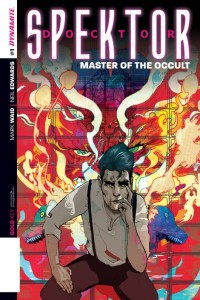 Doctor Spector: Master of the Occult #1 — Writer: Mark Waid; Art: Neil Edwards
Doctor Spector: Master of the Occult #1 — Writer: Mark Waid; Art: Neil Edwards
This reboot of the old Gold Key character imagines him as a reality-show star who gets ratings by chasing after vampires and other supernatural creatures; he’s charismatic but damaged, and his flaws — plus the first-issue introduction of a young assistant who must learn to cope with him — remind me of Waid’s old Crossgen title Ruse, maybe cross-pollinated with the Vertigo series Midnight, Mass. Those were both good series, and so is this — Waid’s an old hand at this kind of thing — although, while it’s all smoothly done, it looks to be well-traveled ground; if you’re looking for the thrill of something new and different, instead of just a solid story, this probably isn’t going to compel you to keep reading it.
 C.O.W.L. #1 — Writer: Kyle Higgins; Art: Alec Siegel
C.O.W.L. #1 — Writer: Kyle Higgins; Art: Alec Siegel
Although it may be hard to tell from the cover, this is a superhero book, set in a Chicago where, after World War II, various costumed characters got the government to let them organize as a quasi-official law-enforcement union (the titular acronym stands for “Chicago Organized Workers League,” which is boring, but necessary for the “cowl” reference to work). Siegel has a painterly, dark-color-saturated style that reminds me of Clayton Crain, and the notion of superheroes as part of a city bureaucracy, with all the petty infighting and office politics involved, offers a couple of new angles. At base, though, this is a superhero-world book, with the same minor variations in powers, good and bad guys, and action that we’ve seen in a thousand previous comics — like Doctor Spektor, it’s fine as light diversionary entertainment, but if you’re looking for something more startling it probably won’t offer much help.
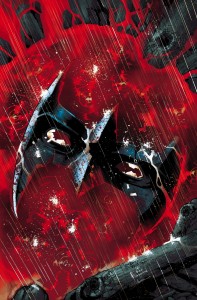 Nightwing #30 — Writers: Tim Seeley and Tom King; Pencils: Javier Garron, Jorge Lucas and Mikel Janin; Inks: Guillermo Ortego
Nightwing #30 — Writers: Tim Seeley and Tom King; Pencils: Javier Garron, Jorge Lucas and Mikel Janin; Inks: Guillermo Ortego
This finishes the New-52 run of this title, since Dick Grayson, as part of the events of Forever Evil, is ditching his costumed persona. That doesn’t mean he’s going away, though — instead, Batman’s asking him (well, not “asking” — this being a superhero comic, they discuss it while having a knock-down, wreck-the-Batcave fight to establish that Dick is Batman’s equal) to (a) let the world think he’s dead (why that’s necessary, especially to people like Alfred, is never made clear; there’s some blah-blah about enemies then knowing who all the Bat-people are, but why couldn’t all the people who, you know, keep the secret that Bruce Wayne’s Batman keep this one too? It’s mostly just Bruce Wayne acting like the kind of obsessed hard-ass dick that he isn’t supposed to be any more), and (b) join the shadowy espionage group Spyral, as a double agent, to investigate their real agenda and get to have adventures in his new comic, Grayson. As a important transition issue to end the old incarnation and launch the new one, this is a comic most DC fans will want to have, although I wouldn’t bet on how long a comic called, simply, “Grayson” is going to last….
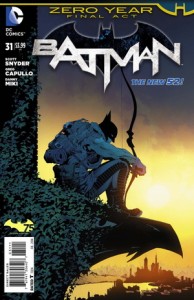 Batman #31 — Writer: Scott Snyder; Pencils: Greg Capullo; Inks: Danny Miki
Batman #31 — Writer: Scott Snyder; Pencils: Greg Capullo; Inks: Danny Miki
In a few months, the New-52 line will be three years old (surprising, right?), and, while JLA was the top seller the first few months, this one quickly took over, and has been there ever since. It’s easy to see why: Snyder, like Geoff Johns, is canny at crafting interesting arcs (which can be easily collected into trades, as perpetual sellers) with power-up villain makeovers of characters like the Joker, or, here in the current “Year Zero” storyline, the Riddler. He has a firm grasp on the core attractions of the hero, and, in Capullo, an artist who’s in tune with his vision and delivers effective, exciting and well-laid-out visuals; add in that they’ve been together and delivering the issues on time throughout the book’s entire run, and it’s easy to see why they’ve built such a passionate fan base.
 Southern Bastards #2 — Writer: Jason Aaron; Art: Jason Latour
Southern Bastards #2 — Writer: Jason Aaron; Art: Jason Latour
The first issue of this series was a medium-level sales hit, with lots of critical praise, and this second installment indicates that it wasn’t a fluke; Aaron, born in the South, has a real feel for the kind of backwater bullies, cornpone corruption and casual redneck ignorance that breed in the poverty and boredom of its small towns, and his reluctant hero, returning to his roots and struggling with the legacy of his dead father, the former sheriff, is clearly going to end up trying to make things right (he doesn’t want to, but by the end of this second issue he’s got a Buford Pusser-worthy big stick in his hands…). If you liked contemporary American noir books like 100 Bullets, or Aaron’s own Scalped, then get in on this now, because it looks to be settling in for a long and entertaining run.
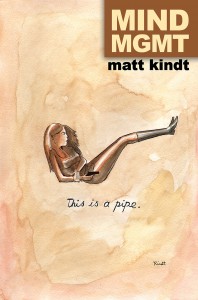 Mind Mgmt #22 — Creator: Matt Kindt
Mind Mgmt #22 — Creator: Matt Kindt
You have to love a book that references Rene Magritte’s “The Treachery of Images” on its cover, and does it so cleverly – not a surprise with Kindt, since this comic has been steeped in surrealism from the beginning; its many psychic agents do little else than play with, and alter, reality. The real surprise is that a book that counts on its readers being so smart, widely read and mentally flexible has made it to 22 issues — an eternity in modern comics time, and reason for optimism about the current market.
 Thanos Annual #1 — Writer: Jim Starlin; Pencils: Ron Lim; Inks: Andy Smith
Thanos Annual #1 — Writer: Jim Starlin; Pencils: Ron Lim; Inks: Andy Smith
This isn’t so much a story as a recap of Thanos’s career, written by the guy who created him and jump-started the genre of “cosmic comics”: one that begins with the rogue Titan’s first appearance as a major bad guy in the ’70s Captain Marvel, winds through the ’80s and ’90s Infinity… mini-series (Infinity Gauntlet, Infinity War, etc.), throws in some Adam Warlock references, and sets the stage for a new chapter, The Infinity Revelation, this August. Those books hold up very well (and have been getting a lot of attention since Thanos showed up at the end of the first Avengers movie), and it’s nice to see Starlin reunited with Ron Lim, his artist on much of that earlier work; for a guy in his fifth decade of writing (and sometimes drawing; there are a number of cover versions of this book, but the best one is by Starlin himself) comics, he’s still a master of the kind of cosmos-spanning, trippy adventures that he summarizes so well here.
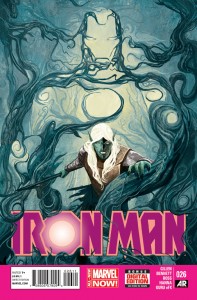 Iron Man #26 — Writer: Kieron Gillen; Art: Joe Bennett and Scott Hanna; Luke Ross
Iron Man #26 — Writer: Kieron Gillen; Art: Joe Bennett and Scott Hanna; Luke Ross
The end of both the Dark Elves and Mandarin stories, at least for now; It’s taken me a while to really warm up to Gillen’s work on this title (he’s been fine on it, but he was following an act — Matt Fraction’s years-long tenure — that was very hard to beat), but this arc’s well-thought-out magic-vs.-technology battles, plus Gillen’s take on the now-Mandarinless Mandarin rings, plus Stark’s relation with his long-lost brother, make me glad I’ve kept reading it, and looking forward to the next chapter in Tony Stark’s life.
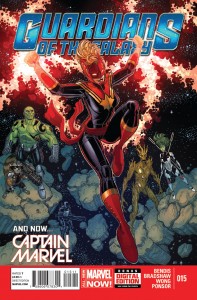 Guardians of the Galaxy #15 — Writer: Brian Michael Bendis; Pencils: Nick Bradshaw and Cameron Stewart; Inks: Bradshaw, Stewart and Walden Wong
Guardians of the Galaxy #15 — Writer: Brian Michael Bendis; Pencils: Nick Bradshaw and Cameron Stewart; Inks: Bradshaw, Stewart and Walden Wong
Guardians of the Galaxy Prelude #2 (of 2) — Writers: Dan Abnett and Andy Lanning; Pencils: Wellinton Alves; Inks: Manny Clark
Will Rocket Raccoon, Bill Mantlo’s fever dream based on a Beatles song, become the breakout character from the Guardians of the Galaxy movie, or just another guy in a Howard the Duck suit? The Prelude is worth it because of Abnett and Lanning’s take on the Rocket/Groot 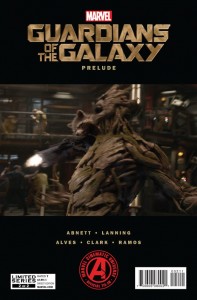 relationship (geek shorthand: Rocket is Han Solo, and Groot is Chewbacca, and they’re swindlers with hearts of gold having space adventures). The regular series’s effort is only a small part of a larger whole: part two of, probably, a six-part for-the-trade story, with the team split up and suffering various humiliations (two more issues to get the band back together and two for the big fight sound about right), so it doesn’t have too much of the furry, anthropomorphic alien. One other problem: it’s got the wrong cover, which announces “And now… Captain Marvel,” along with a big featured action shot of the character, who never appears in the book ; she’s probably scheduled to help rescue everybody in the next issue instead, making a reader wonder what cover should have gone here instead…?
relationship (geek shorthand: Rocket is Han Solo, and Groot is Chewbacca, and they’re swindlers with hearts of gold having space adventures). The regular series’s effort is only a small part of a larger whole: part two of, probably, a six-part for-the-trade story, with the team split up and suffering various humiliations (two more issues to get the band back together and two for the big fight sound about right), so it doesn’t have too much of the furry, anthropomorphic alien. One other problem: it’s got the wrong cover, which announces “And now… Captain Marvel,” along with a big featured action shot of the character, who never appears in the book ; she’s probably scheduled to help rescue everybody in the next issue instead, making a reader wonder what cover should have gone here instead…?
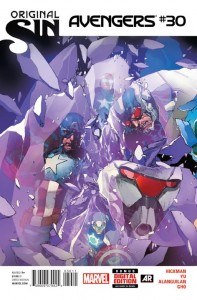 Avengers #30 — Writer: Jonathan Hickman; Pencils: Leonil Francis Yu; Inks: Gerry Alanguilan
Avengers #30 — Writer: Jonathan Hickman; Pencils: Leonil Francis Yu; Inks: Gerry Alanguilan
So, plot summary: Captain America is pissed that Tony Stark and the other Avengers mind-wiped him when he objected to their discussion of whether it would be ethically OK for them to wipe out another Earth if necessary to save both Marvel Earth and the other Earth’s universe, because of an “incursion” causing all the universes to blend into one another, necessitating one’s survival at the expense of the other; meanwhile, the Time Gem, apparently the only artifact left from the Infinity Guantlet (which Cap broke earlier when he used it to stop a previous incursion), is catapulting the team further and further into the future, where they’re getting clues about what might happen next. You can’t accuse Hickman of underestimating the readers’ intelligence, certainly (crises and mind-wipes: who knew he was such a DC fan?), but he might be overestimating their patience; it’s probably time to start wrapping this up.



